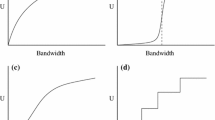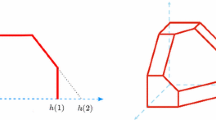Abstract
We use flow-level models to study the integration of two types of Internet traffic, elastic file transfers and streaming traffic. Previous studies have concentrated on just one type of traffic, such as the flow level models of Internet congestion control, where network capacity is dynamically shared between elastic file transfers, with a randomly varying number of such flows. We consider the addition of streaming traffic in two cases, under a fairness assumption that includestcp-friendliness as a special case, and under certain admission control schemes. We establish sufficient conditions for stability, using a fluid model of the system. We also assess the impact of each traffic type on the other: file transfers are seen by streaming traffic as reducing the available capacity, whereas for file transfers the presence of streaming traffic amounts to replacing sharp capacity constraints by relaxed constraints. Simulation results suggest that the integration of streaming traffic and file transfers has a stabilizing effect on the variability of the number of flows present in the system.
Résumé
Nous proposons des modèles de flots représentant l’intégration de deux types de trafic Internet: les transferts de fichiers, ou trafic élastique, et le trafic en temps réel. Les travaux antérieurs ont principalement traité un seul type de trafic, comme les modèles de flots pour la régulation de l’encombrement dans l’Internet, où la capacité du réseau est partagée dynamiquement entre les transferts de fichiers en cours, dont le nombre évolue dans le temps. Nous considérons deux scénarios d’intégration, l’un reposant sur une hypothèse d’équité générale, dont un cas particulier est la compatibilité avectcp (ou «tcp-friendliness »), et l’autre reposant sur une politique de contrôle d’admission des flots temps-réel. Nous considérons une renormalisation des processus décrivant l’état du réseau. Nous donnons des conditions suffisantes de stabilité pour ces processus renormalisés. Nous évaluons aussi l’impact qu’a chaque type de trafic sur l’autre: le trafic élastique a pour seul effet de réduire la capacité offerte au trafic temps-réel, alors que l’effet du trafic temps-réel sur le trafic élastique est de changer des contraintes strictes de capacité en des contraintes pénalisées. Des résultats de simulation suggèrent que l’intégration des deux types de trafic réduit la variabilité du nombre de flots présents dans le système.
Similar content being viewed by others
References
Altman (E.),Artiges (D.), Traore (K.), On the Integration of Best-Effort and Guaranteed Performance Services,inria Research Report No. 3222, July 1997.
Andersen (S.),Blaabjerg (S.),Fodor (G.),Telek (M.), A Partially-blocking queueuing system withcbr/vbr andabr/ubr arrival streams,Tel. Syst. J.,19, no 1, p. 75–99, 2002.
Bain (A.),Key (P. B.), Modelling the performance of distributed admission control for adaptive applications.Performance Evaluation Review, December 2001.
Ben Fredj (S.),Bonald (T.),Proutière (A.),Regnié (G.),Roberts (J.), Statistical bandwidth sharing: a study of congestion at flow level, InProceedings of sigcomm 2001.
Bonald (T.),Massoulié (L.), Impact of fairness on Internet performance, InProceedings of acm sigmetrics 2001.
Breslau (L.),Knightly (E. W.),Shenker (S.),Stoica (I.),Zhang (H.), Endpoint admission control: Architectural issues and performance, InProceedings of sigcomm 2000, p. 57–69.
Bu (T.),Towsley (D.), Fixed Point Approximation fortcp behavior in anaqm Network, InProceedings of acm sigmetrics 2001.
Courcoubetis (C.),Dimakis (A.),Reiman (M. I.), Providing bandwidth guarantees over a best-effort network: call admission and pricing,ieee infocom 2001, p. 459–467.
de Veciana (G.),Lee (T-J.),Konstantopoulos (T.), Stability and performance analysis of networks supporting elastic services,ieee/acm Trans. on Networking,9, p. 2–14, 2001.
Floyd (S.),Fall (K.), Promoting the use of end-to-end congestion control in the Internet,ieee/acm Transactions on Networking,7, p. 458–472, 1999.
Floyd (S.),Handley (M.),Padhye (J.),Widmer (J.), Equation-based congestion control for unicast applications, InProc. acm sigcomm 2000, p. 43–54, Stockholm.
Gibbens (R. J.),Sargood (S. K.),Van Eijl (C.),Kelly (F. P.),Azmoodeh (H.),Macfadyen (R. N.),Macfadyen (N. W.), Fixed-point models for the end-to-end performance analysis ofip networks,13th itc Specialist Seminar: ip Traffic Measurement, Modeling and Management, September 2000, Monterey, California.
Karlsson (G.),Mas (I.),Lundqvist (H.), “qos pdq”, Transactions of the Royal Institute of Technology (trita-imit-lcn r 03:06),isrn kth/imit/lcn/r-03106-se, 2003.
Kelly (F. P.),Key (P. B.),Zachary (S.), Distributed admission control,ieee Journal on Selected Areas in Communications,18, p. 2617–2628, 2000.
Kelly (F. P.),Williams (R. J.), Fluid model for a network operating under a fair bandwidth-sharing policy.Annals of Applied Probability,14, p. 1055–1083, 2004.
Key (P. B.),Massoulié (L.), Probing strategies for distributed admission control in large and small scale systems,ieee Infocom, 2003.
IP monitoring project, Spring labs. http://iprnon.sprintlabs.com
Massoulié (L.),Roberts (J.), Bandwidth sharing and admission control for elastic traffic,Telecommunication Systems,15, p. 185–201, 2000.
Mathis (M.),Semice (J.),Mahdavi (J.),Ott (T.), The macroscopic behaviour of thetcp congestion avoidance algorithm,Computer Communication Review,27, p. 67–82, 1997.
Mo (J.),Walrand (J.), Fair end-to-end window-based congestion control,ieee/acm Transactions on Networking,8, p. 556–567, 2000.
Núñez-Queija (R.),van den Berg (H.),Mandjes (M.), Performance Evaluation of Strategies for Integration of Elastic and Stream Traffic,16th International Teletraffic Congress, Edinburgh 1999.
Padhye (J.),Firoiu (V.),Two sley (D.),Kurose (J.), Modelingtcp Reno performance: a simple model and its empirical validation,ieee/acm Transactions on Networking,8, p. 133–145, 2000.
Racz (S.),Gerö (B.),Fodor (G.), Flow level performance analysis of a multi-service system supporting elastic and adaptive services. Performance Evaluation,49, p. 451–469, 2002.
Rockafellar (T.),Convex Analysis, Princeton University Press, 1970.
Roughan (M.),Erramilli (A.),Veitch (D.), Network performance fortcp Networks, Part I: persistent sources.In Proceedings of itc’17 Brasil, September 2001.
Author information
Authors and Affiliations
Rights and permissions
About this article
Cite this article
Key, P., Massoulié, L., Bain, A. et al. Fair internet traffic integration: network flow models and analysis. Ann. Télécommun. 59, 1338–1352 (2004). https://doi.org/10.1007/BF03179724
Received:
Accepted:
Issue Date:
DOI: https://doi.org/10.1007/BF03179724
Key words
- Teletraffic
- Heterogeneous traffic
- Internet
- Quality of Serice
- Elastic traffic
- Real time
- Modeling
- File transfer
- Fairness




